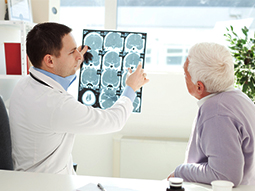Radiculopathy is caused by the compression of a nerve as it leaves the spinal column. The nerve may be pinched or compressed by a herniated disc, bone spur, osteoarthritis, or scoliosis. In rare cases, radiculopathy may be caused by a tumor or infection. Radiculopathy can occur in any part of the back but is most common in the low back (lumbar spine) and neck (cervical spine).
Symptoms
- Radiating pain in the arms or legs
- Localized neck or back pain
- Numbness and/or tingling sensation in the arms or legs
- Weakness in arms or legs
- Loss of reflexes
Radiculopathy symptoms depend on which nerves are affected. Your symptoms can provide important clues about the location of the pinched nerve.
Lumbar radiculopathy involves pinched nerves in the lower back (lumbar spine). Sciatica is a specific type of lumbar radiculopathy that produces pain that starts in the lower back and shoots down one or both legs.
Cervical radiculopathy involves pinched nerves in the neck (cervical spine). Pinched nerves in the cervical region can cause pain, numbness, or weakness that radiates from the neck into the chest or arm.
Thoracic radiculopathy involves a pinched nerve in the middle back (thoracic spine). This form of radiculopathy is less common than lumbar and cervical radiculopathy.
Are you at risk for radiculopathy?
- Performing strenuous activities that place a heavy or repetitive load on the spine. This includes heavy physical labor and contact sports. Weight lifters, football players, dancers, and golfers all have an increased risk of developing radiculopathy
- Having other spine disorders
- Family history of radiculopathy
Tests
Our team of experienced orthopedic surgeons are experts in diagnosing and treating all types of radiculopathy. The first step in radiculopathy treatment is pinpointing which nerve is responsible for your pain and other symptoms. Our initial exam for a suspected irritated or pinched nerve generally includes:
- Taking your medical history to understand when your pain began, and when the pain feels most severe. Our physicians will ask other questions to get a full picture of your health, including whether you have other medical problems and if you take any medications
- A physical exam performed by our physicians to determine where your pain is localized. Physicians may ask you to move and bend your limbs in different directions
Imaging tests to examine the spine and nerves themselves using state-of-the-art imaging techniques, which may include:
- X-ray, which can help determine if the vertebrae bones in your spine are aging or if trauma may be causing the radiculopathy
- MRI, which uses powerful magnets and computer technology to create a picture of your muscles, tissues, nerves, and discs
- CT scan, which combines X-ray technology with computers to provide a very detailed picture of the spine and can show nerve compression
- Nerve test, which can show how well your nerves are functioning, and indicate exactly where there is nerve damage
- Discograms, which involve injections into the discs between your spinal vertebrae to confirm whether a herniated disc is causing your nerve pain
Treatments
Patients often find relief from radiculopathy through non-surgical treatments. These include prescription or over-the-counter anti-inflammatory medications, physical therapy, and avoiding strenuous activities that may further strain the back or the neck. With these treatments, radiculopathy symptoms often subside within 6 weeks to 3 months.
If conservative treatments do not provide relief, spine specialists may recommend epidural steroid injections to reduce inflammation and irritation in the affected nerve. Our specialists use x-ray guidance to pinpoint injections to the compression site.
In certain cases, surgery may be needed to reduce nerve compression and address severe symptoms. The type of surgery recommended will depend on the cause of your radiculopathy. The most common surgeries performed for radiculopathy relief are:
- Laminectomy: The removal of a small part of the spinal bone that surrounds the pinched nerve
- Discectomy: The removal of part of the herniated disc that is causing nerve compression
- Foraminotomy: A minimally invasive procedure to widen the tunnel (foramen) in your back where nerve roots leave your spinal canal and relieve nerve root compression
Our providers

Expert neurology care
Getting the care you need starts with seeing one of our neurosurgeons.









